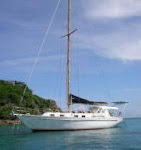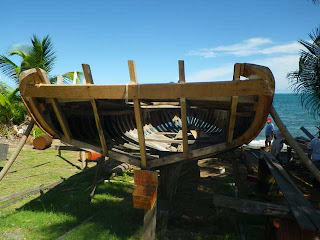'Carriacou and Petite Martinique' is a dependency of Grenada, lying north of Grenada island and south of Saint Vincent and the Grenadines in the Lesser Antilles. The Grenadine islands to the north of Carriacou and Petite Martinique belong to the nation of St. Vincent and the Grenadines.
Carriacou Island in the Caribbean Sea, is the largest island of the Grenadines, an archipelago in the Windward Islands chain. The island is 13 square miles (34 km2) with a population of 4,595 (1991 census). The main settlements on the island are Hillsborough, L'Esterre, Harvey Vale, and Windward.
Thank-you Wikipedia for that wonderful summary!
Now for the insightful offerings of two sailors visiting Carriacou on land for the day. Today we left our anchorage in Tyrell Bay via dingy to a bus, driven by a charming lady graduate of the Carriacou Driving School, to Hillsborough and the Windward side of the Island. It would be negligent of a good sailor not to mention that Carriacou has more than 100 rum shops where people go to 'lime' (which means to talk over the day with friends) and one petrol station where an imperial gallon (larger than a US gallon) of gasoline costs $15-16 EC per gallon. (Exchange rate of $2.67 EC per $1.00 US).
Riding along in the bus we both found ourselves ohhhing and awhhhhhing as the crystal clear waters between Carriacou and Petit Martinique became visible. The turquoise sea changed shades with the depth identifying the numerous reefs. Descending into Hillsborough a horrible sight came into view with the floating curse of a cruise ship spewing boatloads of German tourists into our Caribbean haven.
Fortunately for us we were ready for some lunch and found a delightful waterfront restaurant that was nearly empty and it wasn't because the food was bad. Our table sat just feet from the surf, the wait staff was fun to talk with, and the support staff (a grackle and a dog) provided the occasional entertainment. The only other couple that wandered in from the cruise ship were delightful, verbalizing their joy at finding our we were NOT from the cruise ship. John had chicken with mac'n cheese, pasta salad, pumpkin, plantain, rice and peas, steamed veggies, and shredded cabbage with carrots. Jan had a Chicken Roti that was 'bone in' as the locals like it. The curry, one of her favorite food groups now, was much stronger. Our waitress gave us some tips on making a Roti from scratch, soon to join the Cornish Pastie on Jan's list of favorite recipes. So, now that we know there was no need for dinner or breakfast for that matter, we moved on.
Back on a bus, this one with NO shocks or padding in the seats, and around to the Windward side of the island. Boat building is part of the cultural heritage here that continues to this day. At one point in the history of the island many Scottish and Irish boatbuilders were brought here to build the boats needed for commerce. Today you won't see a factory spewing out boat after boat, you will see a boat builder putting together a boat on the beach, no plans or complex tools necessary.
Alwyn Enoe and his son were working on this sailboat next to their house as we walked by. John had met Alwyn before when he was working on Genesys, the first Carriacou deck sloop that had been built in many years. The completion of Genesys kick-started interest in building and racing both new and renovated traditional boats. These boats are now raced up and down the islands from Trinidad to Antigua. Interesting!
Carriacou boats are designed in the old-fashioned manner: by eye, and without recourse to a tape measure. Their keels are made from greenheart which is imported from Guyana. After the keel has been laid, and the boat has therefore become something more than a rum-shop boast or a smoker’s-dream, the village celebrates the event. In past times the keel was bathed with the sacrificial blood of a goat and blessed by the utterance of secret words, but nowadays, we were told, they don’t usually mess about with the goat; they just roast it and eat it, washing it down with large quantities of Jack Iron.
The boats are framed with a local wood known as white cedar. According to Paul Johnson (himself a boat designer and builder, of course) this timber is good only when it is cut at exactly the right time of year. The Kayak (Carriacou) boat builders choose their own trees, fell them themselves, and arrange their haulage down to the shore. Then they set about cutting the timbers which will form the skeleton of the boat. Most of the frames are grown (which is to say that they are cut from one piece of wood which was especially chosen for its appropriate shape) but we noticed that in each boat a few of the frames were made from timbers which had been scarfed together. The scarfs (or joins) were short (ie they had a only a short overlap) and they were doubled (or reinforced) with pieces of plywood nailed and glued onto one side.
The deck-sloops are planked with cheap Guyanese mahogany, silverballi, which is fastened onto the frames using silicone bronze nails . Each nail costs about 70 cents US.
Not a technique which would be approved by Lloyds, or by anyone who has trained as a Shipwright – quality boat building requires the use of screws – but the method is far from unique. Indeed, we have come across plenty of boats, both on our travels and in the motherland, which were built using nothing better than galvanized nails.
Carnival (see external link below) is held in February or early March. The Carriacou Regatta, held on the first weekend in August, is a racing event for locally built boats. In 2005, the Regatta celebrated its 40th anniversary. Alwyn hopes to launch the boat for Carnival, and race ready by Regatta.
But there was other stuff that caught our eyes as we wandered along.
Flowers are an ever present joy
as are the lovely old clapboard houses with gingerbread trim and lace curtains in every window that fill in the gaps between modern concrete mansions. Pictures speak louder than written words can.
However there were other boats that caught our attention for their contrast to the traditional ones we were looking for.
There was Speedy, a customized little ocean going hotrod that needed to be underway so it didn't sink (note the weight of the motor), a Bequia double-ender (with a cabin to make it a live aboard-unusual for that particular boat) being expertly sailed through the reefs and a 42' modern looking locally built (first boat for this particular builder) racing sailboat all sitting there in front of us off a single dock.
At this point it was time to get back to Elephant's Child having sweat enough for the day. So we boarded another shock absorber-less bus driven by another graduate of the Carriacou Driver's (racing?? ) School and made our way back to Hillsborough where we needed to catch the bus that would take us to Tyrell Bay. Phew....we're almost there!
We can see the boat but wait a minute, where is the dingy? We walked out the dock and could see the painter fastened to the cleat but no dingy. Hmmm, there is an underneath to this cement dock. Great, there's the dingy....but not so great, it won't come out. Well, the story comes out OK in the end. Jan sat in the dingy and pushed up on the bottom of the pier while John bounced on the front. I guess it must have been that more than generous meal we had in Hillsborough, because the weight we 'applied' to the dingy resulted in it's release.
Note to John: we have a stern anchor for the dingy—use it!
We made it back just in time for a Sundowner and beautiful show courtesy of the Lords and Ladies of the Sky.
Another day in Paradise.
Wednesday, October 31, 2012
Subscribe to:
Post Comments (Atom)






















No comments:
Post a Comment